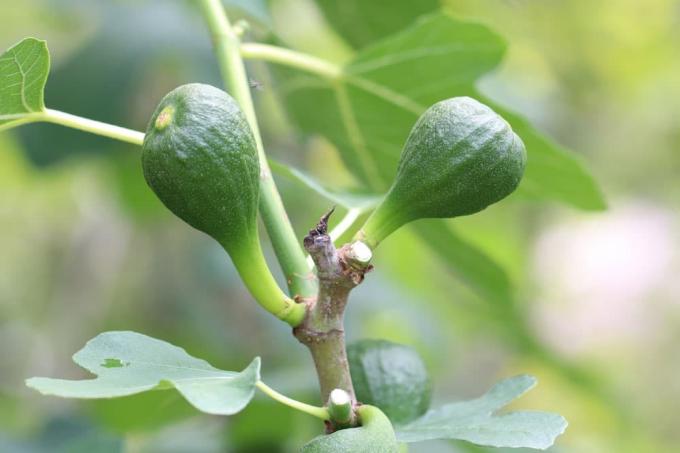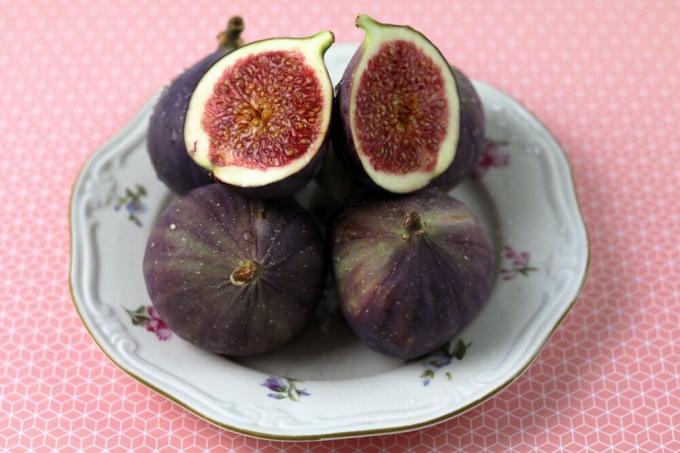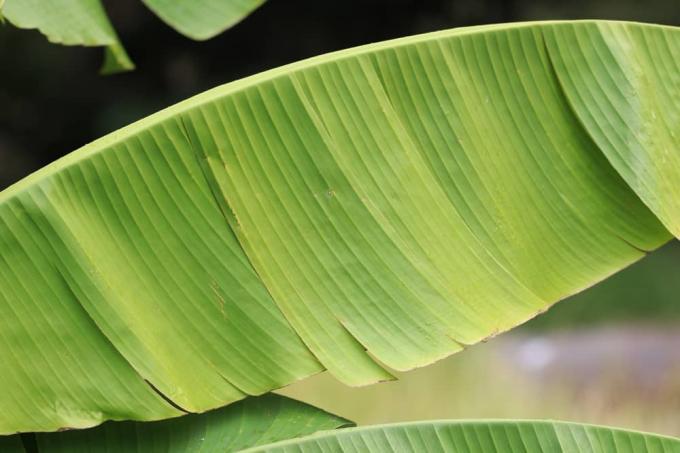

Table of contents
- Characteristics
- Location
- heyday
- Floor
- pot culture
- planting time
- Pour
- Fertilize
- Cut
- wintering
- diseases and pests
- propagation
- Care tips for a beautiful growth
The common fig (Ficus carica) is a popular container plant that bears plenty of fruit when cared for properly. In their countries of origin, the plants often reached stately sizes of up to six meters. Although figs can also be cultivated in regions with winter periods, they remain stunted in growth. They usually have to be overwintered frost-free, but there are now breeds that are conditionally hardy.
Characteristics
- Plant family: Mulberry family
- Flowering period: March-June
- Lifespan: up to 90 years
- Poisonous in all parts except for the fruit
- conditionally hardy - depending on the variety
- separate sex plants
- complex pollination ecology
Location
The fig needs a sheltered location in full sun. This not only protects them from frost, but the fruits also develop optimal sweetness. Although there are varieties such as "Paradiso" or "Violetta", which according to the manufacturer can withstand temperatures down to -20°C, the little trees still have to be protected from frost for the first ten years. Although they will not usually die off immediately in forests, the damage to the shoots is often so severe that they do not flower in those years and sometimes also in the next few years.

Although the saplings like it very warm, they appreciate it when the ground around them is shaded. If the tree is planted outdoors, ground cover can be used. Protecting the root ball from too much sun is particularly important when cultivating in pots, as the roots can be damaged if there is too much heat.
heyday
Flowering often varies according to the variety and the surrounding climate. In very warm and mild regions, the trees can even bloom and bear fruit up to three times a year. As a rule, however, the period in which the trees can ripen fruit in temperate regions is only sufficient for a one-time harvest.
Tip:
If the tree is planted in a frost-free winter garden, then the owners can look forward to a constant and plentiful harvest.
Floor
The advantage of the fig is that it does not place any above-average demands on the soil. The floor should be like this:
- nutritious
- profound
- relaxed
Waterlogging should be avoided in any case. If the soil is too compacted, it can be loosened with a mixture of sand and clay granulate, for example. Gravel should be avoided, however, as the fig does not particularly appreciate lime.
pot culture
When cultivating in pots, it is particularly important to ensure that no waterlogging occurs. When it comes to the composition of the substrate, a mixture of garden soil and compost is completely sufficient for the fig tree. The pot should be big enough for the plants, but not too big. If the pot is too big, the plant will concentrate too much on root growth and only produce moderate fruits.
When choosing a planter, you should pay attention to a high level of stability. The Ficus carica has very large leaves and thus offers the wind a good surface to attack. So that the trees in the pot cannot be blown over so easily, a rather heavy bucket made of clay or concrete should be chosen.
Tip:
To make it easier to move to the winter quarters, you can choose a bucket on wheels.
planting time
With a pot culture, it doesn't matter when the fig is planted. However, if it is a variety that comes outdoors, it should not be planted before mid-May. Up to this point, the plant can already become accustomed to the climate during the day. However, they should only be planted out when there are no more frosts.

It is also possible to plant plants that are overwintered frost-free indoors outdoors during the summer. However, the effort of repotting is very large and only advisable for very small plants. In the case of large plants, the root system is often damaged too severely, which means that the fruits also fail to appear.
Pour
Although the fig tree prefers a warm climate, it still likes consistently moist soil. Rainwater is ideal for watering. What figs don't like at all is lime, not only in the soil, but also in the form of irrigation water. Long-term calcareous water can even kill the plants. A regular supply of water is essential, especially when the first flowers appear. During periods of drought, the plant sheds flowers and unripe fruit to protect itself. Therefore, the substrate should always be constantly moist.
Waterlogging should also be avoided. When cultivating in a pot, a drainage layer made of clay granules, for example, can be created as the bottom layer to be on the safe side. In the case of an outdoor location, the soil must be optimally prepared beforehand. It is sufficient to loosen the soil deeply and to add sufficient sand.
Fertilize
Although figs need sufficient nutrients for good development, too rich ones However, substrate can cause the trees to only grow taller and forget about flowers to build. The first fertilizer application of the year can be done in early spring. A long-term fertilizer such as horn shavings or a solid fertilizer pressed into pellets is ideal for this. This covers the basic needs of the tree.
From the beginning of the flowering period, the tree must be supplied with additional nutrients. A liquid fertilizer that can be absorbed quickly is ideal for this. There are suitable fertilizers for potted plants on the market, but they are not always suitable for plants whose fruits are eaten. Alternatively, you can make your own plant fertilizer.
For example:
- nettle manure
- animal manure (e.g. from the farmer)
- animal manure dissolved in water
The nettle manure not only promotes growth, it also strengthens the plant in general, making it less susceptible to diseases and pests
Cut
Due to the possibility that the trees can flower three times a year, they are very insensitive when it comes to the time of pruning. However, cutting back in the spring is ideal, as this also promotes growth and flowering. As a rule, the trees have a squat growth due to the climatic conditions, which means that large prunings are rarely necessary.

When pruning, care should be taken to ensure that the individual side branches are free and can be well illuminated by the sun. A light tree not only produces more fruit, they also develop a more intense sweetness when well exposed to the sun.
Cutting instructions:
- remove impeding shoots
- light bush/crown interior
- Leave the stubs of branches if you want new shoots
- remove old shoots
- Radical cut only when there is a risk of aging
wintering
If the plant overwinters outdoors, it must be packed up well in autumn at the latest. Bamboo mats in combination with several layers of fleece are ideal for this. There are now commercially available bubble wraps for wrapping frost-sensitive plants. Here, however, care should be taken to ensure that the tree gets enough air so that moisture can escape. Otherwise, constant damp spots on the bark will weaken it, making the tree more susceptible to pests and diseases.
Tip:
In the pot, the fig is overwintered in a light location. Watering is only moderate during the winter months, unless it should continue to develop flowers and fruits in the winter garden.
diseases and pests
The advantage of the real fig is that it is hardly attacked by pests. Occasionally, ants discover very overripe fruit, which, however, disappear again after harvesting. The fig tree is a little more susceptible to diseases. The following diseases can be dangerous for the plants and lead to a crop failure:
- rust fungus
- Fig Mosaic Virus
- root rot
As a rule, however, these problems only arise if there are care errors. In this case, nettle manure can be used again, which strengthens the leaf structure. In the case of a fungal infestation, a mixture of water and milk (1:1) can also be used. The affected areas are sprayed generously.
propagation
Theoretically, it is possible to propagate figs from seeds. If you look inside the fruit, you can see countless small seeds. The problem with the true fig, however, is that there are male and female plants. The female plants, which later develop the fig fruits, do not necessarily need a male Partner for pollination, however, when propagating from seeds there is a risk of male plants grow.

To ensure that only female plants are propagated, propagation by cuttings is preferred. To do this, cuttings are separated from the mother plant and planted at least two eyes deep in the ground. It usually takes a few months for the cuttings to take root. Therefore, growing cuttings in pots is better than growing outdoors.
Care tips for a beautiful growth
- by watering urgently in spring, watering moderately in autumn
- drain excess water
- from April to September supply the plants with liquid fertilizer every week
- immature fruits can remain on the tree in autumn
 garden editorial
garden editorial I write about everything that interests me in my garden.
Learn more about potted plants

Abalie, Abelia grandiflora: 14 tips for proper care
The large-flowered abalia (Abelia grandiflora) is an extraordinarily easy-care ornamental shrub that delights with numerous funnel-shaped and subtly scented flowers. It is just as suitable as a background plant as a hedge or container plant.

Caring for the tangerine tree properly | 13 tips for the tangerine tree
Many citrus plants have evolved from the tangerine, one of the oldest and most original citrus species. With its white flowers and orange fruits, it is a feast for the eyes and the palate. In this country it is only cultivated as a container plant due to its sensitivity to frost.

Indian canna, Canna indica | 13 tips for care
Canna indica, also known by the botanical name Canna indica, is a decorative plant that not only enriches every garden during flowering. In pot culture, it can be used as an accent for many years thanks to its color and growth.

11 absolutely hardy container plants
Absolutely hardy potted plants have several advantages to offer, because they can remain outdoors even when the temperature is below zero and require little protection. If they are also evergreen, they can also bring joy all year round.

Is dwarf bamboo hardy? | 11 tips for care & cutting
Dwarf bamboo is one of the easy-care sweet grasses. In the garden, it can be used as a good ground cover, as it does not grow as tall as its larger relatives. Whether the plant is hardy and how it is cared for and cut can be read in the guide.

Pink dwarf banana, Musa velutina | Care of the Kenya Banana
The pink dwarf banana (Musa velutina) is an eye-catcher in the garden. It grows to a maximum of two meters and impresses with its impressive flowers. The small pink fruits taste sweet and aromatic. If you want to harvest the exotic fruits, you should follow our care tips.



